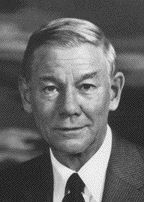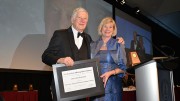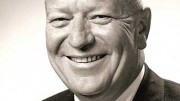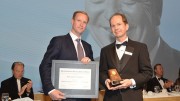The Canadian Mining Hall of Fame will induct six new members at a ceremony slated for Thursday Jan. 19, 2006, in the Canadian Room at the Fairmont Royal York Hotel in Toronto.
The master of ceremonies for the evening will be Newmont Mining president Pierre Lassonde, friend and longtime business partner of Seymour Schulich, who is one of the six inductees.
The others are physicist John Convey, the late former Alcan executive Nathaniel Davis, former Rio Tinto Iron and Titanium executive Bruce Grierson, professor Richard Hutchinson, and prospector James McDougall.
Grierson, Hutchinson, McDougall and Schulich are expected to attend the ceremony. Convey won’t likely be there owing to health reasons.
For tickets or further information, call Nean Allman at (416) 480-0251 Fax: (416) 483-6142 E-mail: cmhf.info@sympatico.ca
John Convey (born 1910)
John Convey made ground-breaking contributions to metallurgy, atomic physics and minerals research, but is perhaps best known for guiding several Canadian agencies and institutions to prominence, most notably the Canadian Mines Branch [since renamed the Canada Centre for Minerals and Technology (CANMET)] during its greatest period of growth and influence. Convey provided technical expertise and leadership to the Royal Canadian Mint, the Canadian Welding Development Institute, and numerous industry associations and societies.
Convey was internationally renowned for the broad and beneficial influence he had on the organization, direction, policy and planning of metallurgy, mining and materials science throughout Canada. He was a strong advocate of research and was in frequent demand as a speaker because of his ability to communicate the benefits of technological innovation to government, industry and the public.
Born in England to a coal-mining family, Convey moved to Alberta in 1929. He graduated from the University of Alberta in 1933 with a degree in physics, followed by a master’s in atomic physics in 1936. After earning his PhD in atomic physics from the University of Toronto in 1940, he enlisted in the Royal Canadian Navy, only to be seconded to the Royal Navy in the U.K., where he helped “de-fang” the magnetic mines that threatened Allied shipping. He was elected a fellow of the British Institute of Physics for his metallurgical contributions to the war effort, and in 1942 earned its Sorby Prize for original research. He undertook special assignments in Canada and U.S. until 1945, and in 1946 headed a British intelligence agency screening German scientists involved in wartime metallurgy and nuclear physics.
Convey began his peacetime career as an associate professor at the University of Toronto, where he organized an extension of the physics department in Ajax, Ont., for the influx of postwar students. He accepted the position of chief metallurgist in the Physical Metallurgy Laboratories of the Canadian Mines Branch in 1948, and was appointed chief of the Physical Metallurgical Division when it was formed in 1949.
Convey was appointed director of the Mines Branch for the federal Department of Energy, Mines and Resources in 1951. He served there for two decades, during an unprecedented period of economic growth. He convinced political leaders that Canada needed to develop technology to maintain its competitive edge, and before long, his department’s laboratories became centres of excellence for national research into mining, metallurgy and energy resources. As a scientist, he championed the need for independent research, yet as a pragmatist, he called for closer collaboration between industry and science so that new technology could be developed for the betterment of society. As Canada’s industrial economy grew, so did the need for standards and quality control. Convey lent his expertise and foresight to agencies such as the Canadian Standards Association and the Canadian Welding Development Institute. He also guided the Royal Canadian Mint during a period of transition to circulation coinage with metal alloys.
Convey’s achievements earned him honorary degrees and numerous industry awards, including the Alcan Award in 1972, and the Canadian Institute of Mining, Metallurgy and Petroleum’s Blaylock Medal in 1956 for his contribution to the development of controlled atomic energy in Canada.
Nathaniel V. Davis (1915-2005)
For almost 40 years, Nathaniel Davis was the driving force behind Alcan as it grew into a Canadian-based global leader in the multi-faceted aluminum industry. A man of extraordinary vision, he built smelters and hydroelectric facilities in Canada to produce quality low-cost primary aluminum, which led to the development of the value-added fabrication sector, which remains a significant contributor to the nation’s economy. He also ensured Alcan’s continued growth by developing new mines, smelters, and fabricating plants elsewhere in the world.
Soft-spoken and unassuming, Davis introduced Alcan to the world, and the world to Alcan. Under his tutelage, “doing the right thing” became a corporate discipline long before it became fashionable practice. His principles were incorporated into a formal manifesto in 1978, representing one of the earliest forerunners to modern corporate codes of conduct.
Davis was born in Pittsburgh, Penn., in 1915. He graduated from Harvard in 1938 and the London School of Economics a year later, and then joined Alcan, where he worked on wartime shipments of Canadian aluminum to America. He also contributed to the war effort personally, serving as an officer in the U.S. Navy, mainly in the Pacific Theatre, from 1942-1945. In 1947, at 32, Davis succeeded his father, Edward, as Alcan president to become one of the youngest chief executives of a large international company.
The postwar period saw increased demand for aluminum, then viewed as a “wonder metal” for its usage in transportation, building, power transmission and packaging. Davis guided Alcan as it embarked on what was then the largest private undertaking in Canadian history, the Kitimat-Kemano project in northwestern British Columbia. Work began in 1950 with the development of a major hydroelectric project and a 286,000-tonne capacity aluminum smelter. Davis updated Alcan’s smelters in Quebec and production doubled, reaching 800,000 tonnes per year by the late 1980s, contributing to the success of the fabrication sector in Quebec and Ontario. He nurtured Alcan’s growth as the company invested in new bauxite mines, notably in Jamaica, and in new plants and smelters in dozens of countries. During his tenure as chief executive, Alcan’s net assets increased by 15 times, dollar sales by 29, and net profit by 16. By 1986, seven years after Davis became non-executive chairman, Alcan was a $6-billion global business, with 67,000 employees worldwide, including 16,000 in Canada.
Davis was a philanthropist, serving for 33 years as chairman of the Arthur Vining Davis Foundations, which were created by his uncle. In 2004, these foundations gave grants totalling almost US$10 million in support of educational, cultural, scientific and religious institutions in the United States. But his greatest legacy may be the remarkable reverence he engendered among employees and colleagues in Canada and abroad. If one measure of a corporate leader is to be more mentor than mogul, then Davis was a leader with few peers. As a former employee wrote upon his death: “His tenure as CEO and as chairman covered one of the most exciting periods of Alcan’s international development. But it is as a person, as a human being, that he touched the lives of many of us. He set a tone of integrity and honesty that could be felt in everything Alcan was doing.”
Bruce J. Grierson (born 1939)
Bruce Grierson made lasting contributions to the mining industry in Canada and abroad during his 40-year career with Rio Tinto Iron & Titanium (RIT) and its subsidiary, QIT-Fer et Titane (QIT).
As a young process enginee
r, he helped renew QIT’s complex at Sorel, Que. The Sorel facility, the world’s largest open-arc electric smelter, treats ilmenite shipped from QIT’s mine in the Lac Allard area of Quebec. Grierson then led construction of the Richards Bay Minerals project in South Africa, which treats beach-sand ilmenite to produce feedstock suitable for a range of uses, and helped develop specialty products which brought the company into new markets. When he retired in 2000, RIT was the world’s largest supplier of titanium feedstock for pigments used in paint, paper, and plastics, with annual sales exceeding US$1 billion.
Grierson was more than an innovative metallurgical engineer and astute businessman developing and marketing mine-derived products. He motivated project teams and corporate colleagues through common goals and shared purpose. He won the support of stakeholders for mining-related ventures through humour, humility, and an uncanny ability to connect on a personal level with people from all walks of life.
Grierson joined QIT after graduating from McGill University as a metallurgical engineer in 1961. His first feat was to organize a multi-disciplinary research team that developed computerized process-control systems for the QIT smelter, thereby greatly improving productivity.
QIT’s next challenge was to produce a feedstock product suitable for use in the growing chloride process market, since Sorelslag, a feedstock employed in the sulphate sector, was unsuitable for use in the chloride process. Grierson thought of using QIT’s smelting process to produce higher-quality products from beach-sand ilmenite, which had lower levels of chemical impurities. To that end, he helped the company identify significant reserves of beach-sand ilmenite at Richards Bay, South Africa.
In 1974, Grierson was appointed CEO of the QIT-led consortium that built a mine and processing complex at Richards Bay. The operation combined new mining techniques, concentration aboard floating dredges, heavy-minerals separation and upgrading plants, and innovative smelting technologies. The project proved a technical and commercial success, and had the support of local communities. Richards Bay is the world’s largest single facility treating heavy minerals, and is matched in scale only by QIT’s smelting operations in Quebec.
The 1980s saw Grierson climb the ranks at QIT and later RIT, initially as the first Canadian to be appointed as the company’s president and chief operating officer, and later as chairman and CEO. During this period, new specialty products were developed in rapid succession, including high-purity iron and steel products, steel powders, and a high-grade feedstock product called Upgraded Slag. More than 80% of the products sold by the company today did not exist before 1975.
In 2001, the University of Sherbrooke in Quebec awarded Grierson an honorary PhD in recognition of his work in the technical area.
Richard W. Hutchinson (born 1928)
Richard Hutchinson has made enduring contributions to mineral exploration during his career as an economic geologist and educator. He was among the first to recognize and document characteristics of specific base metal and gold deposits, which led to standards, or models, used by geologists throughout the world for new discoveries.
Hutchinson is a visionary scientist able to bridge the gap between academia and the practical world of exploration. He has presented geology with a strong economic focus, and encouraged industry to embrace new ideas and theories. In the field, he contributed to a series of diverse discoveries ranging from base metals in New Brunswick, to potash in Saskatchewan, and rare-earth deposits in Manitoba and Mozambique. In the classroom, he mentored and inspired a generation of students, with many later rising to industry prominence. He made their search for mineral deposits exciting, challenging, and in many cases, rewarding.
A native of Ontario, Hutchinson earned a bachelor of science degree from the University of Western Ontario in 1950, followed by a master’s in 1951 and a PhD in 1954 from the University of Wisconsin. Upon graduation, he worked in mining for a decade, and then spent the next three decades in academia, first at the University of Western Ontario and later at the Colorado School of Mines. He also worked as a consultant, which further stimulated his interest in geological controls and the origins of mineral deposits.
While no mineral deposit failed to capture his interest, Hutchinson is best known for his concise articulation of the key attributes of the syngenetic model for volcanogenic massive sulphide (VMS) deposits. His original work, first published in 1965, provided exploration criteria that underpin the global search for these valuable deposits today. It has been aptly said that he brought VMS deposits “to a level of understanding that two successive generations of geologists have arranged into a symphony of metallogeny and classic solo pieces.”
Hutchinson also championed models for various types of gold deposits and brought them to the acceptance and application they enjoy today. His theories were used to make important discoveries in the Thompson-Bousquet camp of Quebec, and helped identify the Izok Lake VMS deposit in the Northwest Territories. He contributed to the recognition of gold deposits in the Hemlo camp of Ontario, and developed methods to identify productive pegmatites as sources of “high-technology” metals.
Hutchinson has authored or co-authored hundreds of papers published in academic and industry journals. His awards are numerous and varied. They include: the Canadian Institute of Mining, Metallurgy and Petroleum’s Barlow medals in 1970 and 1979; the Geological Association of Canada’s Duncan Derry Gold Medal in 1983 for distinguished contributions to mineral deposits geology; the Colorado Scientific Society’s Past President’s award in 1984; the Society of Economic Geologists’ Silver Medal in 1985 for excellence in original work in geology of mineral deposits; the Geological Society of South Africa’s Jubilee gold medal in 1990, for the best paper published in 1988 in the Journal of South African Geology; and the Penrose Gold medal of the Society of Economic Geologists in 2005 for unusually original work in earth sciences.
A tireless speaker, he has shown a remarkable ability to add excitement and passion to scientific discussions and debates. His industry peers maintain that his legacy is best reflected in the success of the many students in industry, academia, and government whom he inspired and mentored over three decades — “an army of geological disciples now spread around the globe.”
James McDougall (born 1925)
During a career that has spanned more than half a century, James McDougall has earned a reputation for boldly going where few geologists have ever gone. It is said that his footprints can be found on just about every mineral occurrence in British Columbia, the Yukon and Alaska, where he has found or helped discover more than 16 major mineral deposits. His most significant and famous discovery lies within a park and will likely never be mined, but his pioneering work in the discovery of the Windy Craggy copper-gold-cobalt deposit puts him right alongside Canada’s other great minefinders.
McDougall was born in Grand Forks, B.C., to a family of mining pioneers. He served overseas during the Second World War, returning home to study geology at the University of British Columbia. He earned his BSc degree in 1951, and a master’s in mine engineering three years later. After graduation he joined the Ventures group of companies, then under the helm of renowned minefinder Thayer Lindsey, and remained there when it became part of Falconbridge. He was appointed manager of western exploration in 1970, and held the position until he “retired” in the 1980s, only to become a sought-after consultant.
McDougall’s legacy of discovery reflects the diverse mineral potential of the western Cordillera. His credits include the Catface porp
hyry copper deposit on Vancouver Island’s west coast, the Tasu iron-copper mine on the Queen Charlotte Islands, the Banks Island gold project near Prince Rupert, and the Sustut copper deposit in north-central B.C.
McDougall’s technical skills, vision, and dedication to working whenever there was daylight all contributed to his prospecting success, but another equally important factor was his willingness to explore rugged and remote wilderness areas. He was among the first to use fixed-wing planes and then helicopters to explore new terrain — “because they let you go further and stay longer” — and among the first to make use of advanced geochemical and geophysical techniques.
Windy Craggy was discovered in 1957 when McDougall and his crew, geologist W.W. Wilkinson and prospector Meade Hepler, investigated iron-stained rocks in the extreme northwestern corner of B.C. He traced mineralized boulders up the side of a steep mountain and discovered a deposit mostly obscured by valley glaciers and debris. In subsequent seasons, he carried small packsack drills up the mountain and obtained the first ore-grade intercepts in drill core. More than $50 million was subsequently spent to develop the world-class deposit. Before long Windy Craggy was viewed as having potential to rival the giant Sullivan silver-lead-zinc mine in the south. In the early 1990s, environmental groups successfully lobbied the government of the day to block further development. The entire area around Windy Craggy was declared a National Park in 1995, and was recognized as a World Heritage Park by the United Nations a year later. Even so, the discovery firmly established “Jimmy Mac” — as he is affectionately known — as one of British Columbia’s most talented, tenacious and successful geologists.
McDougall was named Prospector of the Year in 1985 by the Prospectors and Developers Association of Canada. In 1987, he received the H.H. Spud Huestis Award for Excellence in Prospecting and Mineral Exploration from the B.C. and Yukon Chamber of Mines.
Seymour Schulich (born 1940)
As a financier, company-builder and philanthropist, Seymour Schulich has few peers among his generation. He transformed the Canadian mining industry and launched one of its greatest success stories when he applied the concept of royalty investing from the oil-and-gas sector to the gold business and co-founded Franco-Nevada Mining with partner Pierre Lassonde. The company acquired royalties covering Nevada’s richest gold deposits, found and built a mine of its own, and grew from an initial market capitalization of $3.5 million in 1983 to more than $3 billion in 2002, when it merged with Newmont Mining.
Schulich was born and raised in Montreal, where he earned a BSc degree from McGill University in 1961. A $1,600 scholarship allowed him to complete his MBA degree from the same institution in 1965. After earning a CFA designation from the University of Virginia in 1969, he began his career with Shell Oil Co., where he developed an affinity and appreciation for resource industries that paid dividends when he joined the newly formed firm, Beutel, Goodman and Co. He became a partner and vice-president, then vice-chairman emeritus, as the company grew into one of the largest pension fund management firms in Canada.
Schulich was the first to apply the oil-and-gas royalty model to the gold business when he co-founded Franco-Nevada in hopes of gaining consistent revenue from production protected from cyclical prices. The company paid US$2 million to acquire royalties covering a small heap-leach mine in Nevada. The investment paid off handsomely when Barrick Gold developed the cornerstone Goldstrike property into one of the largest and most profitable gold-mining operations in the world.
Schulich and Lassonde formed a second royalty company and expanded their portfolio of royalties into other metals and commodities, even diamonds. In the 1990s, they developed the Midas gold-silver property into one of Nevada’s most profitable mines. Australia’s Normandy Mining subsequently acquired the mine for 20% of its shares and a 5% royalty. When a South African company made a bid for Normandy in 2001, Schulich and Lassonde convinced Newmont Mining to make a rival bid, and at the same time acquire Franco-Nevada through a friendly merger. Franco-Nevada shareholders ended up with a 32% stake in the world’s largest gold-mining company, while Schulich became chairman of Newmont’s merchant banking division, Newmont Capital.
Schulich has brought entrepreneurial energy and financial ingenuity to the mining industry, and bravely championed its causes on many occasions. His legacy to society is no less extraordinary, and has been aptly described as “one of the greatest expressions of philanthropy in modern history.” Over the course of a decade, he bestowed more than $150 million of his personal fortune to universities and hospitals. The list includes $20 million to McGill University’s faculty of music, $25 million to the University of Calgary’s engineering faculty, $26 million to the University of Western Ontario’s faculty of medicine, and $22 million to York University’s renowned Schulich School of Business and its new building.
Schulich has earned many awards and honours, among them the Order of Canada in 2000. He was named “Developer of the Year” by the Prospectors and Developers Association of Canada in 1998, and with Pierre Lassonde, was named “Mining Man of the Year” by The Northern Miner in 1997.





Be the first to comment on "Canadian Mining Hall of Fame adds six inductees"